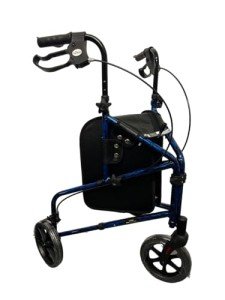walking-aids4136
walking-aids4136
Five Killer Quora Answers To Indoor Walker
The Rise of Indoor Walkers: A Comprehensive Guide
Indoor walkers have actually emerged as a popular option for individuals seeking to keep an active way of life within the confines of their homes. These flexible machines accommodate a diverse audience, from fitness enthusiasts to those recovering from injuries. This post will explore the fundamentals of indoor walkers, their benefits, types, and some considerations to bear in mind before buying one.

What is an Indoor Walker?
An indoor walker is a fitness maker created to replicate walking without the need for outdoor space. Unlike conventional treadmills, which mostly focus on running and jogging, indoor walkers emphasize a natural walking movement. They are geared up with features that promote stability, support, and convenience, making them appropriate for a vast array of users.
Why Choose an Indoor Walker?
Indoor walkers come with a myriad of benefits that attract users of all ages and fitness levels. A few of the primary advantages consist of:
- Convenience: They can be utilized anytime, despite weather or time, making it simpler to fit exercise into a hectic schedule.
- Low Impact: Indoor walkers are developed to lower pressure on joints, making them an outstanding alternative for those with mobility concerns or joint concerns.
- Space-Efficient: Many designs are compact and easy to store, fitting into studio apartments or homes with restricted area.
- Variety of Workouts: With adjustable speeds and strength levels, users can customize their workouts to their fitness objectives.
Types of Indoor Walkers
Indoor walkers come in numerous designs, each accommodating different user requirements. Here are some of the most common types:
| Type | Description | Suitable For |
|---|---|---|
| Manual Walkers | Run by the user, moving the arms and legs in a walking motion. | Newbies seeking a basic, affordable alternative. |
| Motorized Walkers | Equipped with a motor to manage speed and incline settings. | Those wanting a more versatile exercise experience. |
| Under-desk Walkers | Compact devices that fit under desks, promoting walking while working. | Individuals working from home wanting to remain active. |
| Recumbent Walkers | Permit users to walk in a seated position, minimizing tension on the body. | Older grownups or those with mobility obstacles. |
Key Features to Consider
When picking the ideal indoor walker, numerous features can affect the general exercise experience. Here are some important factors to consider:
- Size and Portability: Ensure it fits your designated workout location and is quickly movable if needed.
- Weight Capacity: Check the maximum weight limit to guarantee safety during exercises.
- Adjustable Settings: Look for machines that use adjustable speed and slope settings to customize your exercises.
- User-Friendly Display: Choose an indoor walker with an easy-to-read display screen that tracks time, range, calories burned, and speed.
- Comfort Features: Consider cushioned manages, adjustable height, and a sturdy base for enhanced stability and comfort.
Health Benefits of Indoor Walking
Participating in routine indoor walking can yield various health benefits:
- Enhanced Cardiovascular Health: Walking increases heart rate and enhances blood flow, lowering the danger of cardiovascular disease.
- Weight Management: Regular walking, combined with a balanced diet, aids in weight control and can add to weight loss.
- Improved Mood: Physical activity releases endorphins, which can help decrease feelings of anxiety and anxiety.
- Enhanced Muscles: Indoor walking enhances the leg muscles and improves general body coordination and balance.
Establishing a Walking Routine
To optimize the benefits of indoor walking, it’s important to establish a constant routine. Here are some pointers to begin:
- Create a Schedule: Dedicate particular times throughout the week for walking. Go for at least 150 minutes of moderate aerobic activity weekly.
- Heat up and Cool Down: Always start with a 5-minute warm-up to prepare your body and finish with a cool-down to help healing.
- Listen to Your Body: Pay attention to how you’re feeling. If you experience pain or pain, stop and assess your body’s needs.
Often Asked Questions (FAQs)
Q: How much area do I need for an indoor walker?A: Most indoor walkers are compact and require a little footprint. It’s suggested to have at least 6 to 8 square feet offered for a safe workout area. Q: Can indoor walkers be used by olderadults?A: Yes, indoor walkers are excellent for older adults as they provide low-impact workout while promoting stability and mobility. Q: Do I need a health club subscription if I have an indoor walker?A: No, having an indoor walker enables you to take part in cardio exercises at home, negating the need for a fitness center subscription for walking exercises. Q: How do I maintain my indoor walker?A: Regularly inspect for loose screws, tidy the machine after use, and follow the manufacturer’s standards for specific upkeep schedules. Q: Are indoor walkers ideal for rehabilitation?A: Yes, many indoor walkers are created to support rehab, particularly for clients recovering from surgical treatment or injury. Constantly consult with a healthcare expert before beginning a brand-new workout routine. Indoor walkers use a hassle-free and efficient way to incorporate physical activity into every day life. With their numerous health benefits, user-friendly styles, and flexibility, they are an excellent investment for anyone looking to enhance their
fitness levels in the comfort of their home. By comprehending the different types of indoor walkers, key features to think about, and the health benefits of walking, individuals can make educated choices that align with their fitness objectives. With commitment and the best devices, staying active has never ever been much easier.


